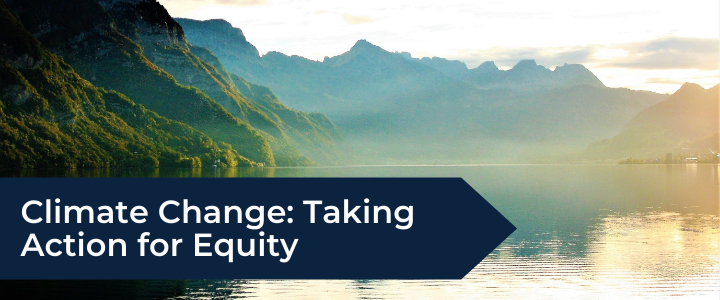
Global climate change is expected to cause hundreds of thousands of deaths from malnutrition, vector-borne diseases, water-borne diseases, air pollution, and heat stress over the next decades. Climate change has led to the increased frequency of extreme weather events, disruption of food supplies, mental health issues, and the displacement of population. The impacts of climate change affect a variety of populations, but the burden of climate-related diseases and health risks are felt by the most vulnerable and disadvantaged, including
- women
- children
- older adults
- poor communities
- those with underlying health conditions
- and displaced persons
Environmental justice and climate change are connected. Climate change affects all of us, but low-income communities, communities of color, people with chronic disease or disability, children, and the elderly are the most at-risk. Race and ethnicity, socioeconomic status, age, and education are among the factors that affect health outcomes.
Lower-income cities are often hotter than higher income neighborhoods because they have more asphalt and less green space, creating heat islands. Therefore, climate solutions present an opportunity to build health equity into our policies and practices at all levels. Promoting equitable climate and clean energy solutions will create a more healthy and prosperous future for everyone.
Although climate change is a global crisis, local grassroot efforts may be the best path forward. Tailored to address specific climate concerns, cities throughout the U.S. are adapting to climate change and protecting those most vulnerable to its health impacts.
Community-based empowerment and participation can be the key in creating inclusive and successful climate/health interventions.
Kasondra McCracken & Matt Weinburke, SOPHE Environmental Health CoP Chairs
Here are some examples of how this is being done:
Extreme heat adaptation: Cooling Centers in Arizona.
More extreme heat events as the climate changes will lead to increased cases of heat stroke, dehydration, and cardiovascular diseases.
This is significant in areas that are already seeing triple-digit summers, such as Phoenix, Arizona, that have Emergency Cooling Centers. An online interactive map identifies cooling centers in community centers and churches. Cooling centers provide water and a safe, air-conditioned space for those who are unhoused or without air conditioning.
Extreme weather adaptation: Flood-Proofing Hospitals in Texas.
In periods of heavy rainfall, there is an increased risk of flooding, leading to waterborne illnesses, displacement, respiratory diseases, and food insecurity. Heavy rainfall is especially dangerous when flooding occurs near hospitals and other medical centers. The impact can be catastrophic for patients, medical providers, and hospital research. In order to adapt to an increased risk of flooding, hospitals in Texas are “flood-proofing” using submarine doors. Inflating these doors can withstand up to 12 feet of water. Many people face barriers in accessing health services, so flood-proofing hospitals is an essential step in protecting health care access.
Vector-borne diseases adaptation: Free Mosquitofish in California.
As the climate changes, we will see emerging diseases in areas we haven’t before: such as Zika, Dengue fever, West Nile Virus, and Lyme disease. The County of San Diego Vector Control Program offers free mosquitofish to residents. Using mosquitofish to control mosquito populations in residential ponds and fountains are some local efforts to reduce vector-borne diseases. This can protect children who play outside or outdoor workers.
Poor air quality adaptation: Preventing Wildfire with Goats in California.
Poor air quality is a health threat. After a series of devastating fires in California, a town is using goats to help clear land of extra brush to prevent wildfire. Many vulnerable communities to wildfire impacts, include
- low-income communities
- migrant populations
- non-English speakers
- communities of older adults
- farmworkers
- and people living with disabilities
Health professionals and national health organizations are urgently called to act. We need public health professionals to translate the effects of climate change on health and increase local and regional climate/health adaptation programs. We urge you to consider ways to take action in your local communities to address climate change and health.
In 2020, SOPHE adopted the Addressing the Health Impacts of Climate Change Resolution and has committed to increasing professional education and awareness to address the health impacts of climate change. The Environmental Health Community of Practice group is active within SOPHE to bring about awareness of the health impacts of climate change.
Kasondra McCracken, MS, MCHES® and Matt Weinburke, DrPH, MPH, MCHES®, REHS | SOPHE Environmental CoP Chairs
Please contact Kasondra McCracken (Ka****************@as*.edu) or Matt Weinburke (mw********@gm***.com) (SOPHE’s Environmental Health Community of Practice, Chairs) for further information or questions.



